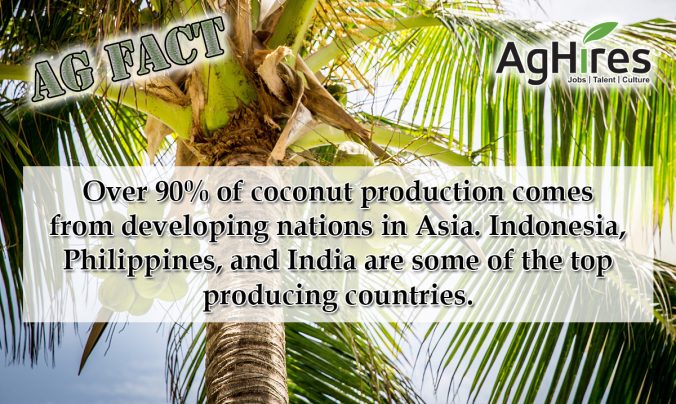
Ever wonder where coconuts and coconut products come from? Not many commercial coconuts are grown in the United States. Within the U.S. they can be grown in Hawaii, Florida, and some territories such as Puerto Rico, Guam American Samoa, and the U.S. Virgin Islands. However, most of these fruits come from Asia. Check out 15 more ag facts about coconuts below.
- Over 90% of coconut production comes from developing nations in Asia, with the Indonesia, Philippines, India, Brazil, and Sri Lanka being the world’s biggest exporters.
- Most coconuts are produced on small plantations.
- There are over 150 species of coconuts across 80 different countries.
- Coconuts are drupes, not a nut. Other drupes include plums, cherries, almonds, and olives.
- Coconuts are not only used as food, but they are also used in the production of various wooden items, in the construction industry, in makeup and other beauty products, and as a fuel.
- The trees can be dwarf and tall. Dwarf trees are between 20 to 60 feet in height and tall trees grow to up 98 feet.
- To grow a new tree, unhusked ripe nuts are laid on their sides close together in nursery beds covered with soil. After about 4 to 10 months they are transplanted between 26 to 33 feet.
- It takes new trees 5 to 6 years to bear fruit, while full fruit bearing takes 15 years.
- Coconut trees have 13 to 20 inches long pinnate leaves that can reach 24 to 35 inches long.
- The trees develop male and female flowers and can be distinguished by size. Female flowers are larger in size.
- It takes a year for the fruit of the tree to become fully ripe.
- On average a coconut tree produces 30 fruits each year, but a tree can produce up to 75 coconuts per year with optimal weather conditions, which is rare.
- About 61 million tons of coconuts are produced each year.
- All parts of the coconuts can be used. Husk and shell are as fuel and source of charcoal. Coconut oil is used as a substitute for diesel fuel.
- In the wild, coconuts can survive up to 100 years.
Want more Agriculture Facts? Click here
Follow us on Facebook and Twitter to get your weekly dose of Ag Facts.
Sources:
WorldAtlas.com
Food and Agriculture Organization of the United Nations
SoftSchools.com
Britannica.com
We think these coconut facts are nuts!






